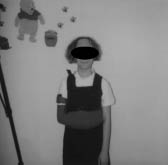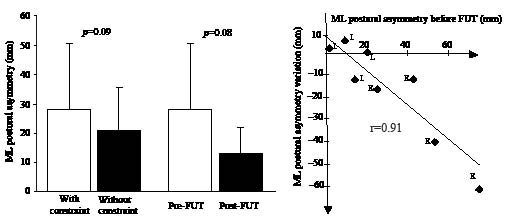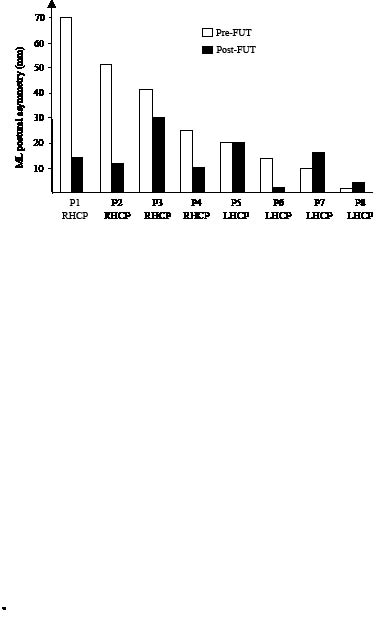Laurent Ballaz, PhD1,2,3, Anne-Fabienne Huffenus, PhD1, Céline Lamarre, MD1, Louise Koclas, MD1 and Martin Lemay, PhD1,2,3
From the 1Centre de Réadaptation Marie Enfant, CHU Sainte Justine, Montréal, Québec, Canada and 2Département de Kinanthropologie, Université du Québec à Montréal, Montréal, Québec, Canada and 3Groupe de Recherche en Activité Physique Adaptée (GRAPA)
OBJECTIVE: To evaluate the impact of forced use therapy on posture in children with hemiplegic cerebral palsy.
DESIGN: Single group pre- and post-training assessments.
SUBJECTS: Eight children (mean age 10.5 years (standard deviation 1.26 years)) with hemiplegic cerebral palsy Levels I and II on the gross motor function classification scale.
METHODS: All participants underwent 12 days (6 h/day) of forced use therapy. Postural asymmetry as well as the centre of pressure range and peak velocity during quiet standing were evaluated before and after the therapy. Upper limb functional level was also assessed using the Bruininks Oseretsky test of Motor Proficiency and the Assisting Hand Assessment.
RESULTS: Before forced use therapy, postural asymmetry tended to decrease when the participants wore the upper limb constraint. After forced use therapy, upper limb functional scores improved significantly, and postural asymmetry tended to decrease, compared with the pre-therapy values. Postural improvement was correlated with postural asymmetry before forced use therapy. No significant differences were observed on the centre of pressure displacement parameters during the quiet standing tests in all conditions.
CONCLUSION: This pilot study showed that forced use therapy may be an efficient way to improve postural asymmetry in children with hemiplegic cerebral palsy.
Key words: forced use therapy; postural asymmetry; posture control; hemiplegic cerebral palsy.
J Rehabil Med 2012; 00: 00–00
Correspondence address: Laurent Ballaz, Laboratoire du Mouvement et de la Cognition (MOCO), Centre de réadaptation Marie Enfant (CHU Sainte-Justine), 5200, Bélanger Est, Montréal (Québec) H1T 1C9, Canada. E-mail: laurent.ballaz@gmail.com
Submitted May 2, 2011; accepted October 21, 2011
INTRODUCTION
Impaired motor functions of the involved limbs, poor balance and postural asymmetry are critical factors that limit children with hemiplegic cerebral palsy (HCP) from performing routine daily activities. Constraint-induced movement therapy (CIMT), developed by Edward Taub et al. (1), uses a task-oriented approach delivered in a massed practice schedule and forces the patient to use the affected arm by means of immobilization of the unaffected one. Forced use therapy (FUT) is similar to CIMT but is less structured and does not require repetitive task practice. One of the specific aims of FUT is to encourage, during the treatment, the spontaneous use of the affected limb in daily activities. To date, several studies have reported an improvement in involved upper limb function after FUT alone (2, 3) as well as after CIMT (4).
In a critical review, Charles & Gordon (5) emphasized the need to investigate the impact of upper limb FUT on posture. Because postural control is an integral part of upper limb motor abilities, improvements in upper limb function could also result in an improvement in postural control as well as upper limb motor control. Moreover, it has been shown recently that CIMT involving the upper limb also resulted in a decrease in the gait base of support, suggesting that upper extremity FUT can increase stability through postural adaptation (6). Hence, FUT could result not only in improvements in upper limb functions, but also in posture. This hypothesis is also supported by the fact that unilateral reaching movement leads to weight transfer on the ipsilateral lower limb (7). Therefore, FUT may lead to an important solicitation (massed practice) of the whole affected side, which, in turn, may result in a positive impact on postural asymmetry commonly observed in persons with hemiplegia (8). Improvements in reactive balance and posture have already been reported in this population after lower limb massed practice (9). On the other hand, wearing a sling leads to changes in body mass distribution and could necessitate postural adjustments that might be causing detrimental effects on postural control. In fact, several studies have shown that upper limb immobilization with a sling alters balance in healthy people (10) as well as in people with hemiplegia (11). Nevertheless, the sling’s or FUT’s impact on balance and postural asymmetry has never been reported. The present preliminary study aimed to assess: (i) the effect of wearing a constraint on balance and postural asymmetry in children with HCP; and (ii) the adaptation following FUT.
METHODS
Participants
Eight children (5 boys, mean age 10.5 years (standard deviation (SD) 1.26 years) with HCP level I (n = 6) and II (n = 2) on the gross motor function classification scale were recruited. Their involved upper extremity function ranged between 47 and 91 on the Assisting Hand Assessment scale (12) (Table I). Inclusion criteria were: (i) the ability to follow simple verbal instructions; (ii) the ability to walk independently (with or without assistive devices) and to maintain upright posture without support for at least 1 min. Exclusion criteria were: (i) known cardiovascular disease; (ii) recent (less than 6 months previously) surgical intervention or botulinum toxin A injection in any one of the lower or upper limbs. Four of our participants presented an involvement of the right side and 4 had a left HCP. All children had mild to moderate level of spasticity, and were free of noticeable leg length discrepancy. This study was approved by the ethics committee of the Sainte-Justine University Hospital Research Center and all participants and parents provided written informed consent.
| Table I. Involved upper limb functional level |
| Participants | Involved side | BOT-2a before FUT | BOT-2a after FUT | AHA before FUT | AHA after FUT |
| 1 | R | 17 | 15 | 47 | 48 |
| 2 | R | 22 | 24 | 85 | 97 |
| 3 | R | 18 | 18 | 55 | 53 |
| 4 | R | 16 | 19 | 61 | 77 |
| 5 | L | 18 | 19 | 67 | 73 |
| 6 | L | 28 | 31 | 91 | 92 |
| 7 | L | 17 | 21 | 44 | 55 |
| 8 | L | 19 | 23 | 67 | 73 |
| Mean (SD) | | 19.4 (3.9) | 21.3 (4.9) | 64.6 (16.7) | 71.0 (18.0) |
| aMedian score for BOT-2 manual dexterity subtest in typically developed children: 31 (14). AHA: Assisting Hand Assessment; BOT-2: Bruininks Oseretsky Test of Motor Proficiency; FUT: forced use therapy; L: left; R: right; SD: standard deviation. |
Forced use therapy
FUT was provided during a 3-week summer camp, 6 h per day on 12 non-consecutive days. During the intervention, the children wore a sling on the non-involved upper limb (Fig. 1) in order to immobilize it while they were engaged in many activities that implied either the upper limb specifically (arts and crafts, playing a musical instrument, drawing and cooking…) or the whole body (gymnastics, collective sports…). Participants were not specifically engaged in repetitive tasks and they did not receive other physical therapy treatments during the FUT period.
Fig. 1. Participant wearing a sling.
Assessments
Balance (quiet standing) and posture were assessed before and after FUT. All participants stood quietly on a force plate (Advanced Mechanical Tech Inc., Watertown, MA, USA) cadenced at 120 Hz, with their arms relaxed at their sides. The participants were asked to stand as immobile as possible for 30 s, while looking at a target. This test was performed twice under two conditions: with and without the sling. Individual tracings of foot placement were used to ensure that identical foot position was used for each condition and for pre- and post-FUT test. Reflective markers were placed at the head of the second metatarsus, at the lateral malleolus and at the heel of the participant’s foot to define the base of support (13). An 8-camera motion analysis system (VICON 512, Oxford Metrics, Oxford, UK) with a 60 Hz sampling rate was used to record the marker positions. The centre of the base of support was defined as the barycentre of the polygon defined by the reflective markers (13). Mediolateral (ML) postural asymmetry was assessed using the distance between the mean COP position and the centre of the base of support along the ML axis (14). The more the distance between COP and the centre of the base of support was important, the more the posture was asymmetrical. In order to pool results from right or left hemiplegic participants in the subsequent analysis, only the ML postural asymmetry absolute value was considered. To assess balance, the COP range and peak velocity in ML and anteroposterior (AP) planes were measured for each condition.
Five items of the manual control section of the Bruininks Oseretsky Test of Motor Proficiency (15) were administered to each child before and after therapy to assess fine bimanual skills. The subtests included the following tasks: transferring pennies, sorting cards, stringing blocks, making circles out of dots, and placing pegs into a pegboard. These items were selected because they are common daily activities involving upper limb movements that have already been shown to respond to FUT (2). The Assisting Hand Assessment was also used to assess the effectiveness with which children with HCP make use of their affected hand during bimanual activities (12).
Statistical analysis
All datasets were tested for normality using the Kolmogorov-Smirnov test. Paired t-tests for dependent groups were used to assess sling and FUT effect on ML postural asymmetry, and to compare pre-training and post-training values of the postural control parameters and functional upper limb scales. Pearson product-moment correlation coefficients (r) were calculated to quantify the interrelationship among the measures. p < 0.05 was used to define the significance threshold.
RESULTS
All participants completed the 12 sessions of FUT with no discernible discomfort. As expected, the Bruininks Oseretsky Test of Motor Proficiency subtest score and the Assisting Hand Assessment score improved significantly after FUT compared with the pre-therapy values (t = –2.52, p = 0.04, and t = –2.88, p = 0.024, respectively, see Table I for individual values).
Concerning the balance variables, no significant effect was observed on the COP range and velocity in all conditions (p > 0.05). As for posture, all right HCP children and two left HCP children initially leaned towards the non-affected side. Two left HCP children slightly leaned towards their affected side. Participants with right HCP exhibited greater ML postural asymmetry than participants with left HCP (range 25–70.2 mm and 1–20.3 mm, respectively). Wearing a sling before the therapy tended to decrease ML postural asymmetry (t = 1.92, p = 0.09, Fig. 2). After the therapy, ML postural asymmetry, as measured without the sling, tended to be lower than before the therapy (t = 2.01, p = 0.08, Fig. 2). The amplitude of the reduction in ML postural asymmetry was correlated with the severity of asymmetry before FUT (r = 0.91; p = 0.002, Fig. 2). Interestingly, ML postural asymmetry was improved in all right HCP, the participants who exhibited greater initial asymmetry (Fig. 3).
DISCUSSION
This pilot study is, to our knowledge, the first to evaluate the effect of sling use and FUT on balance and postural asymmetry in children with HCP. The positive effect of wearing a sling on ML postural asymmetry could be explained by the mass redistribution imposed by the sling. Indeed, the sling requires keeping the uninvolved upper limb in a more medial position, which may lead to a medial transfer of the body’s centre of mass.
After FUT, functional skills of the involved upper limb were improved. Such results are in line with previous studies showing that forced use therapy as well as CIMT improve functional skills in the involved upper limb (2, 5). In the non-constraint condition, ML postural asymmetry also tended to be improved compared with pre-FUT values. It could be hypothesized that children with HCP were more prone to shift their weight towards the involved lower extremity during FUT, as shown in unilateral upper limb tasks (7). Hence, the increased use of the paretic side may have led to a positive postural reorganization.
In the present study, postural asymmetry was more important in right HCP than in left HCP participants before therapy. To our knowledge, there is no evidence showing that right HCP children present a more asymmetrical posture than left HCP children, suggesting that the differences observed in this pilot study may be strictly due to the random nature of our participant selection. Improvement in postural asymmetry following FUT is therefore linked to the initial severity of the asymmetry (as shown on Fig. 2, right panel) rather than the affected side. In fact, the 4 participants with the most severe postural asymmetry all showed marked reduction in asymmetry (28–80%) after FUT. The 4 participants with less marked postural asymmetry showed little or no improvement in postural asymmetry, possibly because of the presence of a floor effect or because postural asymmetry was already within normal limits.
Finally, wearing a sling or FUT did not have a significant impact on balance. This suggests that wearing the sling or FUT neither put the patients at risk, nor result in a beneficial impact on balance.
Fig. 2. Effect of constraint (pre-FUT) and the therapy on postural asymmetry. FUT: forced use therapy; L: left; ML: medio-lateral; R: right.
Fig. 3. Effect of therapy on postural asymmetry for each participant. ML: medio-lateral; LHCP: left hemiplegic cerebral palsy; P: participant; RHCP: right hemiplegic cerebral palsy.
Limitations
These results must be viewed with caution because of the relatively small sample size. It should also be noted that the 4 participants with left HCP had small ML asymmetry, which may have decreased the overall sling and FUT effect. Finally, the single group pre-post test design also limits the generalization of the results. Nevertheless, this pilot study highlighted the possible effect of upper limb FUT on ML postural asymmetry, and justifies the implementation of a larger subsequent study.
Conclusion
This preliminary study provides insight into the impact of upper limb FUT on posture. Our study is the first to show that FUT in children with HCP might improve ML postural asymmetry. Following this pilot study, larger studies are required to confirm the effect of upper limb FUT on posture.
ACKNOWLEDGEMENTS
The authors would like to thank Manon Germain (OT), Marie-Claude Cardinal (OT) and Geneviève Henault (PT) for their involvement in the CIMT implementation and the evaluation of upper-limb functions, and Aren Manoukian for proofreading.
REFERENCES





